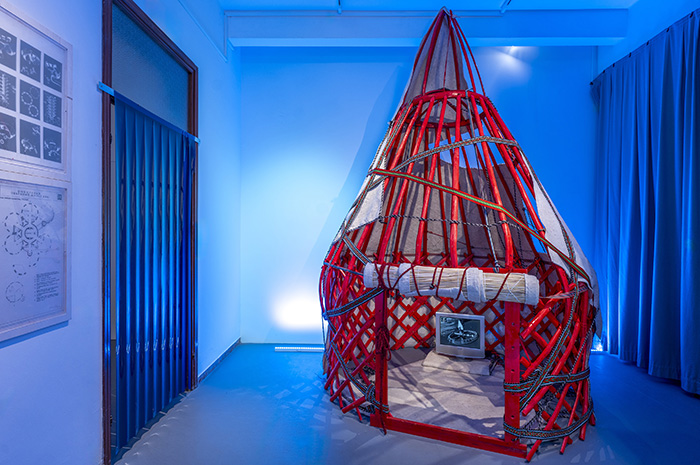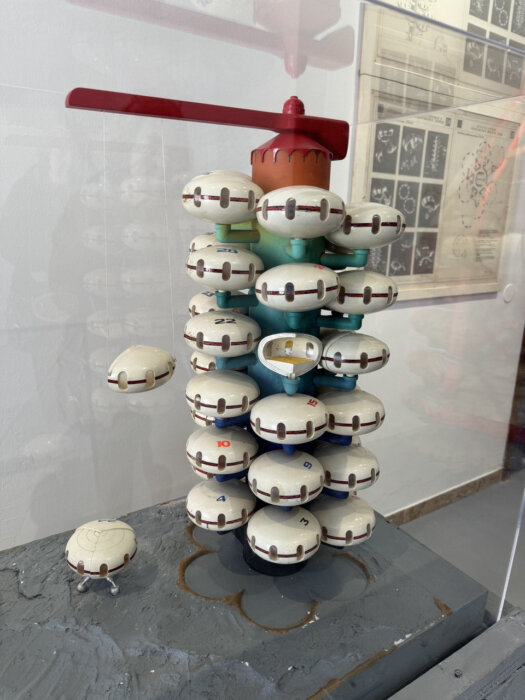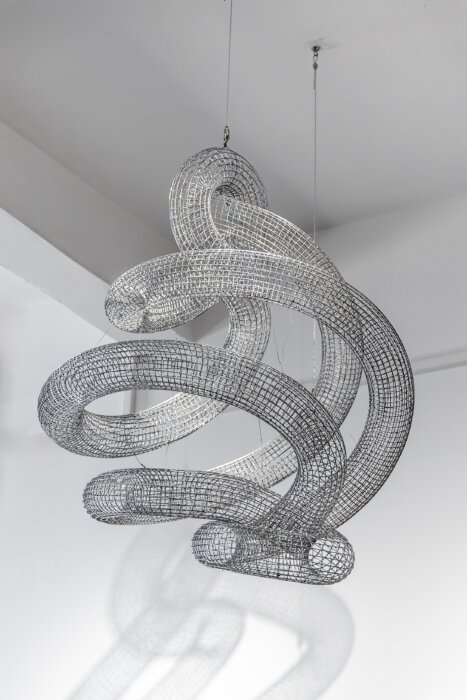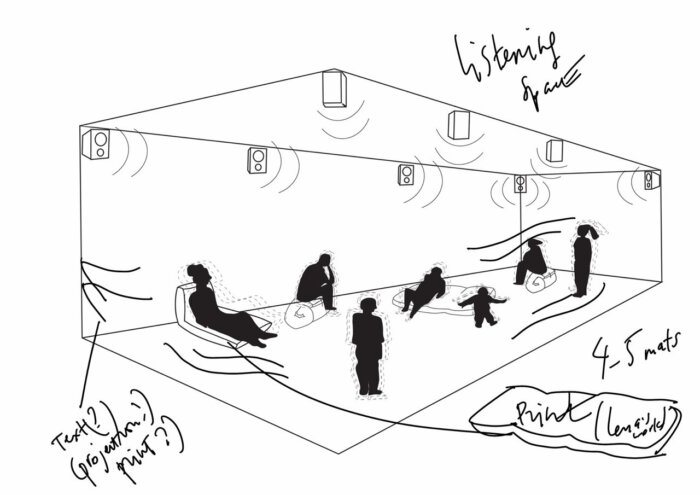Jerūiyq
Journey Beyond the Horizon

1_Decolonial Futurism as Creative Disruption Fiction Making Future Geographies
“Kazakh Wakanda” is Jerūiyq, also known as Zhér-Üyök, a mythical country of universal well-being from ancient Kazakh legends about Asan Kaygy. His name means ‘sad’ or ‘melancholic,’ and he lived in the 14th and 15th centuries, serving as an advisor to the founder of the Kazan Khanate, Ulu-Muhammad, and later to the founder of the Kazakh Khanate, Janibek Khan. Asan Kaygy was also a philosopher, a zhiraу (a folk poet-singer), and a traveler who searched for and glorified Jerūiyq—the promised land where people live without sorrow, penury, or oppression, and where the pastures are so abundant that birds build their nests on the backs of rams.
It is believed that this socio-utopian legend reflects a specific historical situation in the mid-15th century, when the decline of the Golden and White Hordes led to the migration of several tribes to Moghulistan under the leadership of the khans Kerey and Janibek, and the founding of the Kazakh Khanate. [1] According to Danagul Tolepbay, these aspirations resonate not only with the current global situation, in which every person is searching for their place, but also with the main project of the 2024 Venice Biennale, Strangers Everywhere, as set by the curator Adriano Pedrosa. [2]
Thus, geographical imagination finds itself at the center of the project. It connects the question of identity with decoloniality through spatialization. Like the fiction of Wakanda [3], it consciously strives to go beyond the horizon of existing social systems and corresponding systems of knowledge, engaging utopian imagination and science fiction. However, the elements of fiction are not arbitrary: they are based on deeper and more fundamental components of identity, necessarily including presumably pre-modern non-Western and non-capitalist elements. The effectiveness of decolonial futurisms—from Afrofuturism, Sinofuturism, and Ethnofuturism to certain readings of Russian Cosmism and endeavors to establish “comparative futurism” as a research field—is rooted in this combination. [4]
Decolonial futurism is an attempt at a creative disruption, a transgression beyond the existing social and imaginary systems. Artistic decolonial futurisms often strengthen the mutual penetration of art and geography. Researchers have already elaborated on the concept of artful or experimental geography, as well as on art as geographical practice. [5] The opposite is also true: “the ‘expanded field’ of geographic knowledge-making now includes creative practitioners, who see their creative practices as part of the ‘doing’ of geography.” [6] Furthermore, “we could perhaps claim that geography is an emerging exhibitionary discipline, the focus of which is the geographical research exhibition.” [7] Geographer Denis Cosgrove wrote at the beginning of the 1980s that “geography takes over landscape from the hands of the painter.” [8] Today it can take over from the hands of artists decolonial futurism as the practice of making future geographies. [9] Forging new spatial identities and future geographies can happen with speculative artistic imagination or Störungsfiktionen (‘disruption fictions’)—“experimental drillings into the discursive subsurface of reality.” [10] But how exactly do these disruption fictions work in the project?
2_Decolonizing Future Narratives through Art
The exhibition Jerūiyq: Journey Beyond the Horizon was held in the historic building of the Museo Storico Navale di Venezia (Naval History Museum of Venice), located on the Riva S. Biasio embankment, next to the Arsenal—the venue of the main project. Kazakhstan still does not have a permanent or long-term rental pavilion at the Biennale. The only two national projects of Kazakhstan in Venice were carried out in 2022 and 2024 by different teams and in different venues. The 2024 project featured works by six artists, spanning from painting to media art, and covering a period from 1978 to 2024 (Fig. 2).

The exhibition was divided into pairs spread across three small halls. In the central hall, visitors entering directly from the embankment see works by two already deceased classics of contemporary Kazakh art (Fig. 3). The work Baikonur-2 by Sergey Maslov (1952–2002) was created in 2002 with the support of the Soros Center for Contemporary Art in Almaty and exhibited in the same year at the show No Mad’s Land: Contemporary Art from Central Asia at the Haus der Kulturen der Welt in Berlin (Fig. 4). Maslov’s installation started from the formal similarity between a yurt—the traditional dwelling of nomadic Kazakhs—and a rocket (Fig. 4). From this, the artist imagined an ironic alternative history of Kazakhs as cosmic nomads: that they were aliens from Sirius who adapted to earthly civilization. A slide-show film inside the yurt, made up of Maslov’s digital collages, tells this story, mixing imagery of cosmic travels, UFOs, and traditional Kazakh nomadic lifestyle (Fig. 5). Co-curator of the No Mad’s Land exhibition, Valeria Ibraeva wrote that it was “a playful, humorous resolution of the dilemma between the primordial and constructivist explanations of the origin of ethnic groups in favor of constructivism.” [11] It was also the first major exhibition of Central Asian art abroad, featuring 40 artists. Following 10 years of independence from the Soviet Union and its Moscow-centric, ideologically driven art scene, artists from Central Asian countries attempted to develop original art that reflected their local identities. By breaking away from socialist realism (in other words, decolonizing themselves from its narratives), they aimed to engage with global art movements while simultaneously reinterpreting their ancient shamanic traditions [12] (Fig. 6).




Along this path, speculative fictions blended with the revision of traditions, and the imagination of the future became intertwined with a rethinking of the past. This combination remains at the core of decolonial futurisms and is even more relevant today than in 2002, considering the ongoing rise of identity politics and decolonialist narratives in art and cultural production. For the 2024 exhibition in Venice, 22 years later, artists Elena and Viktor Vorobyev, friends of Maslov, recreated the iconic red ‘yurt-rocket.’ Quite rightly, the curators of the Kazakhstan Pavilion 2024 present it as an emblematic representation of Kazakh decolonial futurism.
The yurt also inspired architect, sculptor, and inventor Saken Narynov (1936–2023), whose experimental architectural project Mobile Unit (1979) is exhibited in the same room as Maslov’s work. It presents a mobile space residential unit, from which modular building-transformers can be assembled. This unit can be used for various purposes, such as a dwelling for cattle breeders in distant pastures, for geologists, or colonizers of other planets. Narynov received a patent for this invention in 1981 and never abandoned the idea of realizing it. In his practice, Narynov sought to connect art, architecture, and science in a fundamental way, creating spatial structures that span from architectural projects to public art (Fig. 7). Interested in non-Euclidean geometry, the topology of space, and quantum physics, Narynov created objects like the “Möbius Strip” or the “Klein Bottle” from metal wire. Two of these topological developments, or “Top-Art,” titled Six Lives of One Soul (1990) and The End of the Beginning or the Beginning of the End (2001), are exhibited near his Mobile Unit (Fig. 8).


Narynov’s approaches may seem far removed from Maslov’s postmodernist, provocative irony, but both artists combined utopian and science fiction imagination with a revision of the yurt. This blending of pre-modern and futuristic elements for rethinking spatial identity is highly characteristic of decolonial futurism. By exhibiting their fantasies of mobile dwellings together, the curators suggest that the question of cosmic nomadism can be a central theme for Kazakh decolonial futurism.
Researchers note a close genealogical connection between cosmic and steppe imagination in the Soviet era:
The Soviet steppe has been closely connected to Soviet spacefaring from its inception […]. Together with the agrarian modernity of the Virgin Lands Campaign, the Kazakh steppe was chosen as the background of Soviet space modernity and became both the landing ground for victorious cosmonauts and the drop zone for rocket debris. [13]
The curators do not aim to simply distance themselves from the Soviet experience as a colonial past to be overcome, but rather to reclaim Kazakhstan’s right to it, reinterpreting it with their own images and creating their own Kazakh modernity. This has historical justification and corresponds to the urgent task of decolonizing Russian cosmism. [14] As Musrepov says in a personal conversation with the author: “I don’t want to consider the space program as something that was forcibly imposed on us from outside. We also participated in it! We also launched Gagarin into space!” The abundance of disruptive geo-imagination in its utopian, futuristic, and post-apocalyptic versions leads to the perception of Kazakhstan as the “last earthly frontier […] where thousands of plateaus have absorbed thousands of utopias […] one of the fronts between Earth and space.” [15]
In another room, we meet works by painter Yerbolat Tolepbay and the2vvo, a duo of Kazakh origin based in Berlin. The two Tolepbay’s (b. 1955) canvases were created almost 40 years apart (Fig. 9). The first of them, Aqyr yaman: The End of the World (1985) was titled War at the time of its creation, reflecting apocalyptic anxieties about nuclear war. The painting is executed in contrasting tones with an abundance of black paint, but this dramatic depiction of the world is countered by the bright figure of a baby suspended in mid-air. This can be interpreted as a symbol of hope for a new world, apocalyptically born from annihilation or the ultimate downfall of the current world (Fig. 10).


Forty years later, and specifically for the Venice exhibition, Tolepbay created a large canvas, The New Baby: Rebirth (2024). The black figures, which in the 1985 painting surrounded the baby and symbolized the actual apocalyptic world, have transformed into sharp abstract forms. According to the curators, over the past 40 years, Tolepbay has become disillusioned with all ideologies, including communism and Kazakh nationalism. He has come to believe that a painting can spiritually heal through its forms and colours, which can convey the artist’s pulse to the viewer. Thus, the conflict is translated from the level of figures to the level of abstract forms: the fallen world is now represented by sharp, black abstract forms. However, the baby remains at the centre, offering hope for a way out beyond the horizon of events, signifying a gesture of apocalyptic transgression. It also signifies that one of the most important functions of art today is the production of transcendence. [16] As Musrepov said, in a post-religious contemporary state of society, it is in some sense the role of art to produce an ecstatic experience, an oceanic Freudian feeling [17] (Fig. 11).

Navigation between the tangible and spiritual realms, as well as between nature and culture, and tradition and technology, is further explored in the work of the2vvo, a transdisciplinary artistic duo consisting of Lena Pozdnyakova (b. 1985) and Eldar Tagi (b. 1987). Their sound installation Presence (2024) delves into throat-singing, an ancient tradition of Inner Asia’s Indigenous peoples, recontextualizing it within a modern, globalized, and technologized framework (Fig. 12). Traditionally, throat-singing is a shamanic technique for communicating with the natural and supernatural worlds, a form of ‘sonic holography’ that reflects the interdependence between humans and their environment. The project utilizes another technology, Generative AI, to transform throat-singing, thereby further blurring the boundaries between the human and non-human and challenging anthropocentric views. The immersive sound installation also features rugs for listening, printed with satellite photographs of the rapidly shrinking Aral Sea, a site of lasting environmental catastrophe in Central Asia (Fig. 13; Fig. 14). In this way, the audience’s connection to the environment through ‘sonic holography’ that blends traditional and cutting-edge generative cosmotechnics, takes place in the contemplation of an actual ecological catastrophe. In the context of the current ecological crisis, the nuclear anxiety of the 1980s, as expressed by Tolepbay, seems remarkably relevant to more recent critiques of the Anthropocene, as exemplified by the work of the2vvo. The apocalyptic disruption promised by this crisis fuels artistic imagination, calling for a transformation of our way of life and our relationship with the environment.
Fig. 12: the2vvo, excerpt from the generative sound installation Presence, 2024, © the2vvo and Kazakhstan Pavilion 2024


In the third hall, we encounter another pair of artists whose projects resonate with one another and bridge the generation gap, Kamil Mullashev and Anvar Musrepov (Fig. 15). Kamil Mullashev’s (b. 1944) triptych, Earth and Time: Kazakhstan (1978), a graduation project from the Moscow State Art Institute, has become the artist’s key work. Mullashev repeated parts of it several times with some mostly unintentional variations in technique. Two paintings from the triptych presented at the exhibition are close to photo-realism but deliver a futuro-romantic image of the steppe. In Over the White Desert (1978), large-scale spherical architecture coexists with a nomad on a camel, while a just-landed cosmonaut in Youth (2000 [1978]) practically levitates above the ground with closed eyes against the backdrop of a floating, snow-white parachute and prancing horses. [18] In Mullashev’s vision, the Kazakh steppe of the future appears as a bright dream in blue and white hues, a space of bliss, fresh wind, and weightlessness. The latest technologies coexist here with elements of traditional ways of life, and the environment is clean and comfortable for living. As the curators note, the triptych, being one of the first futuristic images in the history of Kazakh art, emerged in the same period as the term ‘Russian cosmism’ came into use. According to them, it became one of its key images “adding diversity and blurring its mono-ethnic character” [19]—a statement fully in line with the logic of decolonial futurism (Fig. 16, Fig. 17).



In contrast to Mullashev’s light and dreamy vision of the early space travel era, Anvar Musrepov’s (b. 1994) video essay Alastau (2024) presents a post-apocalyptic fantasy. This is also a graduation project, but created 50 years after Mullashev’s, at the Vienna Academy of Arts. The video essay, which plays with the genre of horror movies, tells the story of a post-apocalyptic world without sun, filled with malign spirits. The surviving tribes have returned to nomadism, shamanism, and rituals, such as alastau, a Tengrian ritual of purification. The author emphasizes that the video’s “images and references deeply rooted in Kazakh culture and mythology open up a perspective for the decolonization of future narratives, creating a mystical parable about escape from death.” [20] Musrepov, who is also the curator of the exhibition, here appears as one of its artists. This does not only seem as a conflict of interests, but also as a reinforcement of the artist-curator’s self-assigned mission “to produce our [Kazakh] nomadic futurism, a local movement in perspective.” [21] If a curator is a researcher and activist of decolonial futurism, then their activity has features of an “identity discipline”—“a field dominated by scholars who strongly identify with the subject of their scholarship,” and where the distinction between researcher and researched becomes blurred (Fig. 18). [22]
Fig. 18: Anvar Musrepov, excerpt from video-essay Alastau, 2024, © Kazakhstan Pavilion 2024
3_Disruption Promised and Delayed
Conceptually, the exhibition’s field of meanings also pulsates between dialectical pairs: utopia and dystopia, neo-traditionalism and modernism, the mythological and the secular, cosmos and earth (steppe), absence and presence. However, the works of the artists strive to collapse these pairs, as in any decolonial futurism. Examples of such overlapping are found in the images of the cosmic nomad, the throat-singing produced with the help of GenAI, or the post-apocalyptic world where shamanism is one of the advanced cosmotechnics. At the same time, the effort of transcending ‘beyond the horizon’ of the existing world leads to a new immanence—the land of Jerūiyq. Transcendence and immanence collapse through spatialization, so geographical imagination takes center stage in decolonial futurisms. Each of them, including the experience of the Kazakhstan project in 2024, is an effective strategy for producing visible statements within the framework of international contemporary art. Yet art that produces future geographies and spatial identities through creative disruption fictions is always internally paradoxical due to its pretension to go beyond the horizon of events.
However, a paradox is also contained in the strategy of implementation of disruption fictions—in their pragmatics. The Global South, of which Kazakhstan can be considered a part, is faced with the necessity of producing its own postcoloniality, decoloniality, or indigeneity as a condition for being included in the global art world, which is still dominated by the hegemony of the Global North. Here, we encounter a dialectic: decolonial indigeneity reinforces the existing hegemony by ‘thinning’ it through selective inclusion. Moreover, as argued by authors of critical indigenous theory, such as Jodi Byrd, even radical critical theories of the Global North are based on the reproduction of indigeneity as the “wild other.” [23] This is how the “transit of Empire” occurs—the transfer of its power from one context to another through the reproduction of “paradigmatic indigeneity.” [24] And, of course, progressive art is a prime example of this reproduction, especially in institutions like the Venice Biennale, which is genetically and structurally disposed to the manifestation of identities.
At the level of common sense, many artists from the Global South are pessimistic about how the revolutionary potential of their performative identities and decolonial futurisms is co-opted by the multicultural order of cosmopolitan centers, ultimately serving to maintain the global status quo through selective inclusion. [25] On the other hand, both radical critical theories and decolonial indigenous art constantly strive to transform or disrupt the hegemony, either by thinning it through inclusions to the point where it disappears or by overturning it. This dynamic appears to be a repetition of the dialectical logic of critical theory, aptly expressed by Marx: capitalism breeds its own gravedigger. Thus, the hope that the subjugated subject will one day become revolutionary is always preserved, but at the same time, this moment can be indefinitely postponed. This is the constant paradoxical promise of decolonial futurisms and their disruptive fictions: the Journey Beyond the Horizon remains as imaginary as it is real, and as corroborative in relation to the status quo as it is disruptive, just like the figure of the legendary Asan Kaygy and the promised land of Jerūiyq. Or like another legendary figure—the Turkic poet-songwriter, sage, and composer of the ninth century, Korkyt Ata. His figure, depicted in Musrepov’s video as either constantly gathering sunbeams or falling apart into them, can be read as a symbol of any ambition to journey beyond the horizon, which always seems so close and yet so elusive at the same time (Fig. 19).

_How to Cite:
Nikolay Smirnov. “Jerūiyq: Journey Beyond the Horizon.” On_Culture: The Open Journal for the Study of Culture 19 (2025). <https://doi.org/10.22029/oc.2025.1512>.

_Endnotes
- [1] Kazakhskai͡a SSR: Kratkai͡a Ėnt͡siklopedii͡a, vol. 4 (Alma-Ata: Kazachskaja Sovetskaja Enciclopedija, 1991), 331.
- [2] Anvar Musrepov and Danagul Tolepbay, “Venet͡sianskai͡a biennale 2024: pavilʹon Respubliki Kazakhstan. Kuratory o tematike, ob iskusstve i uchastii gosudarstva, interview by Baur Jean Sagiyev,” TÄJ (videoblog), April 17, 2024, <https://www.youtube.com/watch?v=kgKidxIEzOw>.
- [3] Wakanda is a fictional nation in the Marvel Cinematic Universe, depicted as a technologically advanced and isolated country in Africa, with a rich cultural heritage and a strong sense of identity. The concept of Wakanda has been interpreted as a symbol of decoloniality, representing a hypothetical African nation that has been able to maintain its independence and cultural autonomy in the face of colonialism and imperialism. See, for example, the films Black Panther, directed by Ryan Coogler (2018; Burbank, CA: Marvel Studios/Walt Disney Studios Motion Pictures) and Black Panther: Wakanda Forever, directed by Ryan Coogler (2022; Burbank, CA: Marvel Studios/Walt Disney Studios Motion Pictures).
- [4] E.g., Kevin Michael Angelo Strait, Kinshasha Conwill, and National Museum of African American History and Culture, eds., Afrofuturism: A History of Black Futures (Washington, DC: Smithsonian Books, 2023); Armen Avanessian and Mahan Moalemi, eds., Ethnofuturismen (Leipzig: Merve Verlag, 2018).
- [5] See Angela Last, “Experimental Geographies,” Geography Compass 6, no. 12 (2012): 706–724. doi: 10.1111/gec3.12011; Meghan Kelly, Nick Lally, and Philip J. Nicholson, “On Art and Experimentation as Geographical Practice,” GeoHumanities 9, no. 2 (2023): 380–410. doi: 10.1080/2373566X.2023.2187313.
- [6] Harriet Hawkins, “Geography’s Creative (Re)Turn: Toward a Critical Framework,” Progress in Human Geography 43, no. 6 (2019): 963–984, here: 963. doi: 10.1177/0309132518804341.
- [7] Harriet Hawkins, Geography, Art, Research: Artistic Research in the Geohumanities (Abingdon/Oxon: Routledge, 2021), 196.
- [8] Denis E. Cosgrove, Social Formation and Symbolic Landscape (London: Croom Helm, 1984), 186.
- [9] About the future geographies see for example Richard Baxter, “Home Futures: A House Biography of Futures for a Modernist High-Rise Estate,” Cultural Geographies 31, no. 3 (2024): 297–314. doi: 10.1177/14744740241236985; Ben Anderson and Peter Adey, “Future Geographies,” Environment and Planning A 44, no. 7 (2012): 1529–1535. doi: 10.1068/a45316; Ben Anderson, “Preemption, Precaution, Preparedness: Anticipatory Action and Future Geographies,” Progress in Human Geography 34, no. 6 (2010): 777–798. doi: 10.1177/0309132510362600; Elaine Lynn-Ee Ho, “Social Geography I: Time and Temporality,” Progress in Human Geography 45, no. 6 (2021): 1668–1677. doi: 10.1177/03091325211009304.
- [10] Lars Koch and Tobias Nanz, “Ästhetische Experimente: Zur Ereignishaftigkeit und Funktion von Störungen in den Künsten,” Zeitschrift für Literaturwissenschaft und Linguistik 44, no. 1 (2014): 98. doi: 10.1007/BF03379707.
- [11] Valeria Ibraeva, “Kak Tebe Takoe Ilon Mask?,” in Cergeĭ Maslov: Zvezdnye Kochevniki, eds. Yelena Vorobyeva and Viktor Vorobyev (Almaty: Aspan Gallery, 2021): 8–21, here: 16.
- [12] Peter C. Seel and Hans-Georg Knopp, Online Editorial for the catalog Abseits der Seidenstrasse: Kunst und Kultur aus Zentralasien (Berlin: Haus der Kulturen der Welt, 2003), <https://archiv2004.hkw.de/de/dossiers/AbseitsderSeidenstrasse/c_index.html>.
- [13] Christine Bichsel, Ekaterina Filep, and Julia Obertreis, “The Soviet Steppe: Transformations and Imaginaries—Introduction,” Slavic Review 81, no. 1 (2022): 1–7, here: 7. doi: 10.1017/slr.2022.74.
- [14] Alexey Ulko, “Decolonizing ‘Russian Cosmism,’” in Cosmic Bulletin 2022, accessed March 14, 2025, <https://cosmos.art/cosmic-bulletin/2022/decolonizing-russian-cosmism>.
- [15] Kulshat Medeuova, “Thousands of Utopias: Kazakho-Futurism and the Post-Apocalyptic Imagination,” in The Berliner Gazette, July 29, 2024, <https://berlinergazette.de/thousands-of-utopias/>.
- [16] Celso Sánchez-Capdequi and Josetxo Beriain, “Creativity, Transcendence, and Social Constellations,” Current Sociology 72, no. 2 (2024): 235–252. doi: 10.1177/00113921231190714.
- [17] Musrepov and Tolepbay, “Venet͡sianskai͡a biennale 2024,” 28:20–28:50.
- [18] The artist revisited the triptych several times, producing variations with subtle modifications. In the original version of Youth (1978), three horses appear on the horizon in the left part of the painting, whereas in the version exhibited in Venice, the horses are no longer present. The original variant can be viewed here: <https://rusmuseumvrm.ru/data/collections/museums/gos_muzey_iskusstv_respubliki_kazahstan_im._a._kasteeva/mullashev_k._yunost._1978._gmirk/index.php>.
- [19] Anvar Musrepov and Danagul Tolepbay, Jeruiyq: Journey Beyond the Horizon, accompanying booklet of the exhibition (2024).
- [20] Musrepov and Tolepbay, Jeruiyq: Journey Beyond the Horizon, booklet.
- [21] From a personal conversation with the author.
- [22] Emily D. Johnson, How St. Petersburg Learned to Study Itself: The Russian Idea of Kraevedenie (University Park, PA: Pennsylvania State University Press, 2006), 5.
- [23] Jodi A. Byrd, The Transit of Empire: Indigenous Critiques of Colonialism (Minneapolis: University of Minnesota Press, 2011), 20.
- [24] Jody Byrd speaks of “paradigmatic Indianness,” seeking to identify the origins of the American empire in the colonization of the Indians of the North American continent. However, given the current global stage of this process and the expansion of the number of geocultural contexts that has already occurred, I believe that we can speak of ‘paradigmatic indigeneity.’
- [25] See also Rasheed Araeen’s critique of the exhibition “Magiciens de la Terre” [Magicians of the Earth], which took place at the Centre Georges Pompidou and La Grande Halle, Parc de la Villette, Paris, France, 1989; e.g., Rasheed Araeen, “Our Bauhaus Others’ Mudhouse,” Third Text 3, no. 6 (1989): 3–14. doi: 10.1080/09528828908576208.


